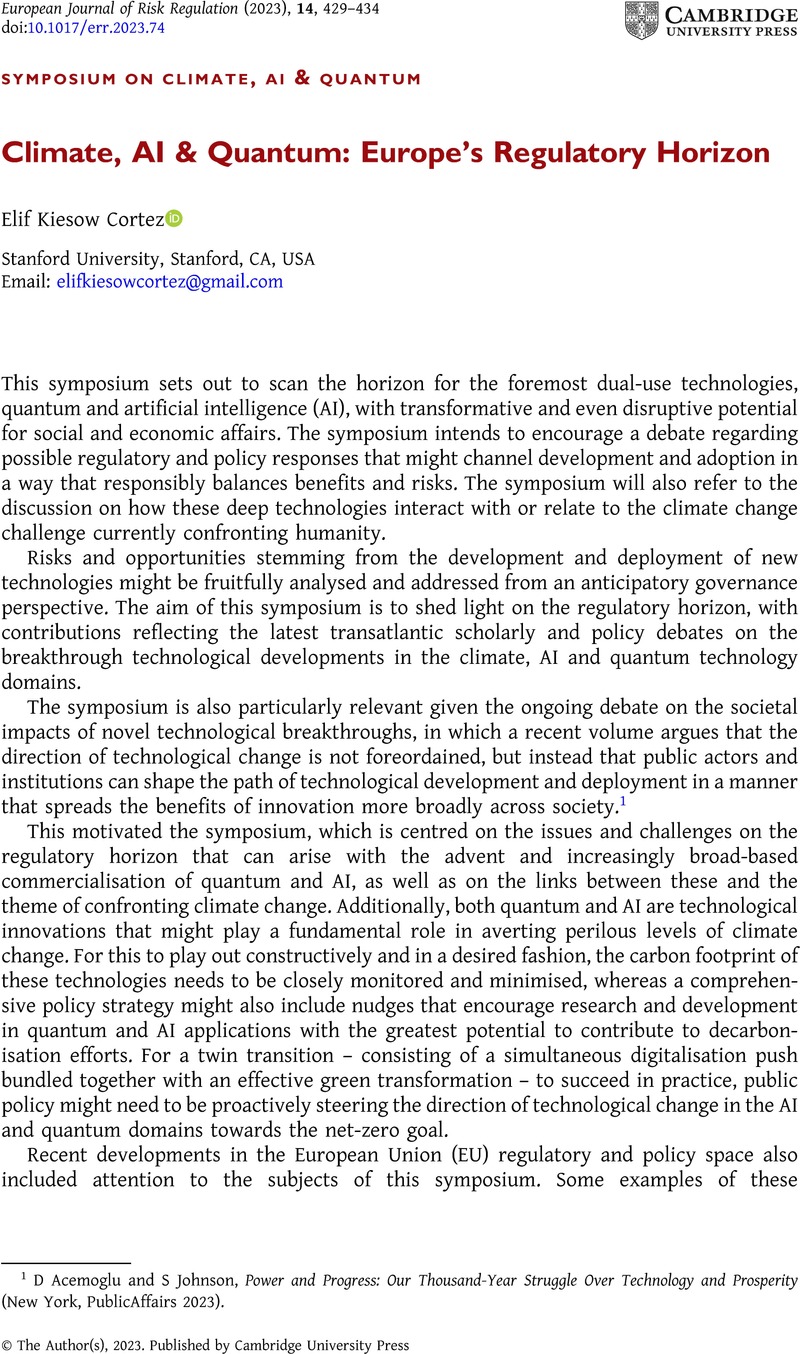No CrossRef data available.
Published online by Cambridge University Press: 30 November 2023

1 D Acemoglu and S Johnson, Power and Progress: Our Thousand-Year Struggle Over Technology and Prosperity (New York, PublicAffairs 2023).
2 European Commission, “A European Green Deal” (14 July 2021) https://commission.europa.eu/strategy-and-policy/priorities-2019-2024/european-green-deal_en (last accessed 18 September 2023).
3 The Inflation Reduction Act (IRA) in the USA is also a related policy programme of significant scale and ambition aiming to pursue climate policy and sustainability objectives.
4 M Kaur, “Overview of Quantum Initiatives Worldwide 2023” (Qureca, 19 July 2023) https://qureca.com/overview-of-quantum-initiatives-worldwide-2023/ (last accessed 18 September 2023).
5 E Gibney, “Europe Plans Giant Billion-Euro Quantum Technologies Project” (2016) 532 Nature 426; Quantum Flagship, “Introduction to the Quantum Flagship” https://qt.eu/ (last accessed 18 September 2023).
6 Real Decreto 729/2023, de 22 de agosto, por el que se aprueba el Estatuto de la Agencia Española de Supervisión de Inteligencia Artificial 2023 122289.
7 European Commission, “Quantum Technologies Flagship” (30 June 2023) https://digital-strategy.ec.europa.eu/en/policies/quantum-technologies-flagship (last accessed 19 September 2023).
8 European Commission, “Green Digital Sector – Shaping Europe’s Digital Future” (24 May 2023) https://digital-strategy.ec.europa.eu/en/policies/green-digital (last accessed 18 September 2023); European Commission, “European Green Digital Coalition – Shaping Europe’s Digital Future” (24 May 2023) https://digital-strategy.ec.europa.eu/en/policies/european-green-digital-coalition (last accessed 18 September 2023).
9 European Commission, “Coordinated Plan on Artificial Intelligence 2021 Review” (21 April 2021) https://digital-strategy.ec.europa.eu/en/library/coordinated-plan-artificial-intelligence-2021-review (last accessed 18 September 2023).
10 Whereas the EU AI Act is the regulatory framework for addressing risks stemming from AI, the Coordinated Plan contains pro-innovation policies aiming to make Europe one of the major international players and an attractive region for AI development. Thus, the European strategy towards AI attempts to strike a balance between regulation and innovation.
11 D Rolnick et al, “Tackling Climate Change with Machine Learning” (2022) 55 ACM Computing Surveys 42.
12 P Cooper et al, “Quantum Computing Just Might Save the Planet” (McKinsey & Company, 2022) https://www.mckinsey.com/capabilities/mckinsey-digital/our-insights/quantum-computing-just-might-save-the-planet (last accessed 8 May 2023).
13 LH Kaack et al, “Aligning Artificial Intelligence with Climate Change Mitigation” (2022) 12 Nature Climate Change 518.
14 European Investment Bank and European Commission, “A Quantum Leap in Finance: How to Boost Europe’s Quantum Technology Industry” (2023) https://www.eib.org/attachments/lucalli/20220112_a_quantum_leap_in_finance_en.pdf (last accessed 23 October 2023).
15 NIST, “AI Risk Management Framework” (12 July 2021) https://www.nist.gov/itl/ai-risk-management-framework (last accessed 18 September 2023).
16 The White House, “Blueprint for an AI Bill of Rights” (October 2022) https://www.whitehouse.gov/ostp/ai-bill-of-rights/ (last accessed 18 September 2023).
17 CS Morgan, F Langlois and J Lan, “U.S. House and Senate Reintroduce the Algorithmic Accountability Act Intended to Regulate AI” (Lexology, 8 April 2022) https://www.lexology.com/library/detail.aspx?g=c9bfbfca-a88e-4fd9-b556-d903a4cf0bd7 (last accessed 14 December 2022).
18 The White House, “FACT SHEET: Biden–Harris Administration Secures Voluntary Commitments from Leading Artificial Intelligence Companies to Manage the Risks Posed by AI” (21 July 2023) https://www.whitehouse.gov/briefing-room/statements-releases/2023/07/21/fact-sheet-biden-harris-administration-secures-voluntary-commitments-from-leading-artificial-intelligence-companies-to-manage-the-risks-posed-by-ai/ (last accessed 18 September 2023).
19 E Kiesow Cortez et al, “A Quantum Policy and Ethics Roadmap” (11 July 2023) https://papers.ssrn.com/abstract=4507090 (last accessed 18 September 2023).
20 The White House, “Executive Order on Addressing United States Investments in Certain National Security Technologies and Products in Countries of Concern” (9 August 2023) https://www.whitehouse.gov/briefing-room/presidential-actions/2023/08/09/executive-order-on-addressing-united-states-investments-in-certain-national-security-technologies-and-products-in-countries-of-concern/ (last accessed 18 September 2023); N Berman, “President Biden Has Banned Some U.S. Investment in China. Here’s What to Know” (Council on Foreign Relations, 29 August 2023) https://www.cfr.org/in-brief/president-biden-has-banned-some-us-investment-china-heres-what-know (last accessed 18 September 2023).
21 K Klyman, “Biden Takes Measured Approach on China Investment Controls” (Foreign Policy, 19 August 2023) https://foreignpolicy.com/2023/08/19/biden-approach-china-economy-investment-control/ (last accessed 18 September 2023).
22 European Commission, “Commission Recommendation of 3 October 2023 on Critical Technology Areas for the EU’s Economic Security for Further Risk Assessment with Member States” (2023) https://defence-industry-space.ec.europa.eu/system/files/2023-10/C_2023_6689_1_EN_ACT_part1_v8.pdf (last accessed 13 October 2023).
23 J Bistline et al, “Emissions and Energy Impacts of the Inflation Reduction Act” (2023) 380 Science 1324.
24 M Swayne, “Quantum Sensing Is a U.S. Department of Energy Priority” (The Quantum Insider, 10 April 2023) https://thequantuminsider.com/2023/04/10/quantum-sensing-is-a-u-s-department-of-energy-priority/ (last accessed 18 September 2023).
25 A Bötticher, J Hernandez, MC Ketteman, V Gast and R Araiza Bravo, “Introducing a Research Program for Quantum Humanities – Theoretical Implications” (this issue) European Journal of Risk Regulation.
26 E Kiesow Cortez and N Maslej, “Adjudication of Artificial Intelligence and Automated Decision-Making Cases in Europe and the USA” (this issue) European Journal of Risk Regulation.
27 A Liman and K Weber, “Quantum Computing: Bridging the National Security–Digital Sovereignty Divide” (this issue) European Journal of Risk Regulation.
28 F Cortez, “Artificial Intelligence, Climate Change and Innovative Democratic Governance” (this issue) European Journal of Risk Regulation.